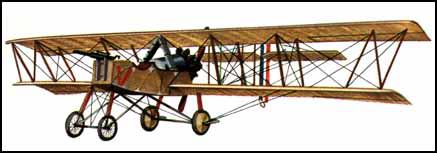Voisin V
Gabriel Voisin was of the most productive aircraft designers of the First World War. On 5th October, 1914 the Voisin III, became the first Allied plane to shoot down an enemy aircraft.
Voisin became the standard Allied bomber in the early years of the war. Successive models were more powerful and over 800 were purchased by the French Army Air Service. The Royal Flying Corps and the Russian and Belgian airforces also used them in the war. The Voisin V first appeared in 1915. It was the first bomber to be armed with a cannon instead of a machine-gun.

Performance Data of the Voisin V | |
|---|---|
Type | bomber |
Engine | 120 hp Canton-Unne |
Wing Span | 48 ft 4 in (14.75 m) |
Length | 31 ft 2 in (9.5 m) |
Height | 12 ft 6 in (3.8 m) |
Maximum Speed | 74 mph (120 kph) |
Maximum Height | 11,485 ft (3,500 m) |
Armament | 37-mm cannon; 132 lbs (60 kg) of bombs |
Primary Sources
(1) In 1916 Arthur Ransome visited the Eastern Front by air in a Russian owned Voisin.
In August I had flown along the front in one of the old two-seated Voisin machines in which the passenger sat as if in an open canoe with a foot on each side of the pilot, in whose stupidity he had the utmost confidence. It was cold in the air and I well remember beating my hand against the outside of the canoe to get my fingers warm enough to take a photograph.
Our real trouble, such as it was, began when just before dusk we flew black to the place from which we had started. We began to spiral down and instantly there appeared puff after puff of smoke from shells sent up to meet us. The pilot suddenly turned the nose of the machine up, pointing with a grin to a small new tear in one wing. Presently he spiralled down again and again was greeted with shells from below. Once more we sheered off, this time with curses, and on coming back yet again we were, at last, recognised as friends and allowed to land.
I dined that night with the battery that had done the shooting, and sat next to the officer in charge. I complained that I did not think he had given me a very hospitable reception. "Perhaps not," he replied. "I'm very sorry, but really you ought to count yourself lucky, for usually when we fire at our own machine we hit it." He explained that the aeroplanes had been given to the Russian army because they were not good enough for the French. They were very slow and therefore easy targets.
